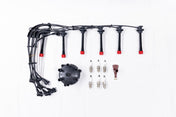Frequently Asked Questions
1FZ-FE Turbo
What year 80/LX450 does the Cruisers and Company turbo fit?
What year 80/LX450 does the Cruisers and Company turbo fit?
The Cruisers and Company 1FZ-FE Turbo kit is designed to fit OBDII compliant FZJ80's from 1995-1997 and LX450's from 1996-1997.
What type of fuel should I use with the Cruisers and Company turbo setup and why?
What type of fuel should I use with the Cruisers and Company turbo setup and why?
The highest grade fuel for your location is what you should be using. Generally, this would be 91-94 in the USA. The grade of fuel is a stability rating. The higher the grade, the more stable gasoline is. This is especially important on a forced induction engine because under the correct conditions when you have fuel, a hot spark plug and hotter compressed air than naturally aspirated, the fuel can spontaneously combust on the wrong engine stroke, causing damage to the motor. By using premium, you limit this because the fuel is less likely to combust under those conditions.
What if I can't get premium fuel?
What if I can't get premium fuel?
If you cannot get premium fuel, try to keep your engine from building boost. One way to achieve this is to disconnect the actuating rod on the wastegate and move the wastegate valve to be completely open so that exhaust gas can bypass the turbine wheel. Another option is to find octane booster and use it according to the instructions on the bottle. Octane booster can be found at most gas stations and auto parts stores. Even after adding octane booster, please drive cautiously until premium fuel can be mixed in.
What should I set my ignition timing to with the turbo kit?
What should I set my ignition timing to with the turbo kit?
We recommend setting the ignition timing to the factory specification of 3 degrees BTDC.
My engine has high mileage and I want to make sure it is healthy before going turbo, what should I do?
My engine has high mileage and I want to make sure it is healthy before going turbo, what should I do?
Find a local automotive shop that you trust, preferably a local cruiser shop that has experience with these engines. Have them perform a coolant system pressure test, a compression test, a leak down test, and check oil pressure with a mechanical gauge. Once you have those values, please reach out to us to discuss the direction that you could go with your engine.
What other items do you recommend updating while turbo-ing my motor?
What other items do you recommend updating while turbo-ing my motor?
Knock Sensor - The 1FZ-FE has two knock sensors. Often times the original knock sensors will pull timing and make the truck stutter/stall after adding forced induction as the combustion event is more powerful and could make them read erroneously. We have them available here.
Fuel Pump - Fuel is necessary for your engine to run and at this point, most fuel pumps have 200K+ miles on them and are often overlooked. A Walbro 255 or 450 or Toyota Supra TT Pump are nice upgrades and will supply all the fuel you need and more. Check fuel pressure after installation to make sure you are withing the specified factory range at idle (265 - 304 kPa (2.7 - 3.1 kgf/cm2, 38 - 44 psi)). Depending on the make/model, you may need to bypass the factory fuel pump resistor and run upgraded wires back to the tank. Also, make sure that if you swap fuel pumps, the fuel pressure regulator you are using can handle the flow.
Fuel Filter - What good is all that fuel if it isn't clean? Dirty fuel can kill an injector, which under load can cause a lean condition leading to the destruction of your motor. Most fuel filter....CHECK WITH JOHNNY ON WHAT SHOULD BE NEXT
Fuel Pressure Regulator - Another likely 200K+ mile part that is often overlooked. A new regulator can help keep your fuel pressure at the optimum value. The stock fuel pressure regulator is a rising rate 1:1 regulator that works well with some fuel pumps. Make sure that if you swap pumps, the fuel pressure regulator you are using can handle the flow.
Ignition Tune Up - What good is fuel and air if it can't combust? We are fans of both the OEM Toyota or the NGK spark plug wires. NGK DO NOT include all the clips that the OEM wires have and those must be transferred over. We have everything you need in one easy bundle here for naturally aspirated and forced induction applications.
Motor Mounts - If you have original, old, not in good shape motor mounts, the extra torque will split them in half. It is much easier to replace the passenger side without the turbo in the way. We recommend the OEM Toyota motor mounts.
What types of gauges should I use to monitor the engine vitals?
What types of gauges should I use to monitor the engine vitals?
We highly recommend everyone with our kit uses the boost gauge (0 - 15 PSI or -30 inHg - 15 PSI), an AFR gauge, and Coolant temperature gauge. All of these should be monitored in conjunction with our turbo kit to keep an eye on your engine vitals. Two 2 & 1/16th gauges fit well on the A pillar under the grab handle when using the Autometer 2 & 1/16th Gauge Pods.
What is a boost gauge and what should I use as a reference source?
What is a boost gauge and what should I use as a reference source?
A boost gauge measures pressure in the intake tract after the turbo compressor. By monitoring this, you can see if you are building the pressure you should be supplying the engine., or if you are over pressurizing the system. The reference points should come from the intake manifold. The kit provides a vacuum/boost tee with an extra 1/8 NPT female port to be able to adapt whatever boost gauge you use.
What is AFR, what does an AFR Gauge measure and what values should I be seeing?
What is AFR, what does an AFR Gauge measure and what values should I be seeing?
AFR stands for Air Fuel Ratio. This is the ratio of air and fuel your engine is burning and at certain load points you should see certain AFR's. This can verify you are receiving the proper amount of fueling under cruise and boost/load. At cruise and when you are not in boost you should see around 14.7:1 on your gauge, this is the stoichiometric or ideal burn for gasoline. Under load, you will see that around 3 PSI of boost your engine will start delivering more fuel and your gauge will drop to ~12:1. Under full load 6-7 PSI, your AFR's should be between 10.5~12 on the gauge. If under full load and you don't see the AFR's drop to that range, back off the throttle immediately and take it easy until it can be determined why fuel isn't being delivered like it should.
How should I monitor coolant temperature and what temperatures are safe?
How should I monitor coolant temperature and what temperatures are safe?
Coolant temperature should be monitored on every 80 Series/LX450. The cooling system needs to be in good working order to shed the extra load from turbocharging your engine. A dedicated gauge and sensor can be installed on the engine and in the cabin or you can use a Bluetooth dongle/scan gauge to broadcast the information to an app on your phone. Johnny uses a Bluetooth dongle and the Torque App on his Android phone. Temperatures should stay below 212 degrees (F) in most cases, and while cruising on open highway 186-195 is ideal. Toyota set the air conditioning to automatically shut off at 226 degrees (F). If you are seeing temperatures close to or upward of 220 degrees (F) then you should back off the gas pedal, slowdown, downshift to get the engine fan spinning at higher RPM, turn the heater on and work the engine less to bring the temperatures down.
What are some recommended gauge brands?
What are some recommended gauge brands?
We have used Speedhut, Isspro, Glowshift, and AEM in the past with good results. If you are looking at Speedhut, we are a dealer for them and can help get you set up!
I have a turbo question that hasn't been answered, how do I reach you?
I have a turbo question that hasn't been answered, how do I reach you?
Please check out our Turbo Torque Kit Document and Installation video and send an email to Info@Cruisersandcompany.com. We will respond as soon as we can.

